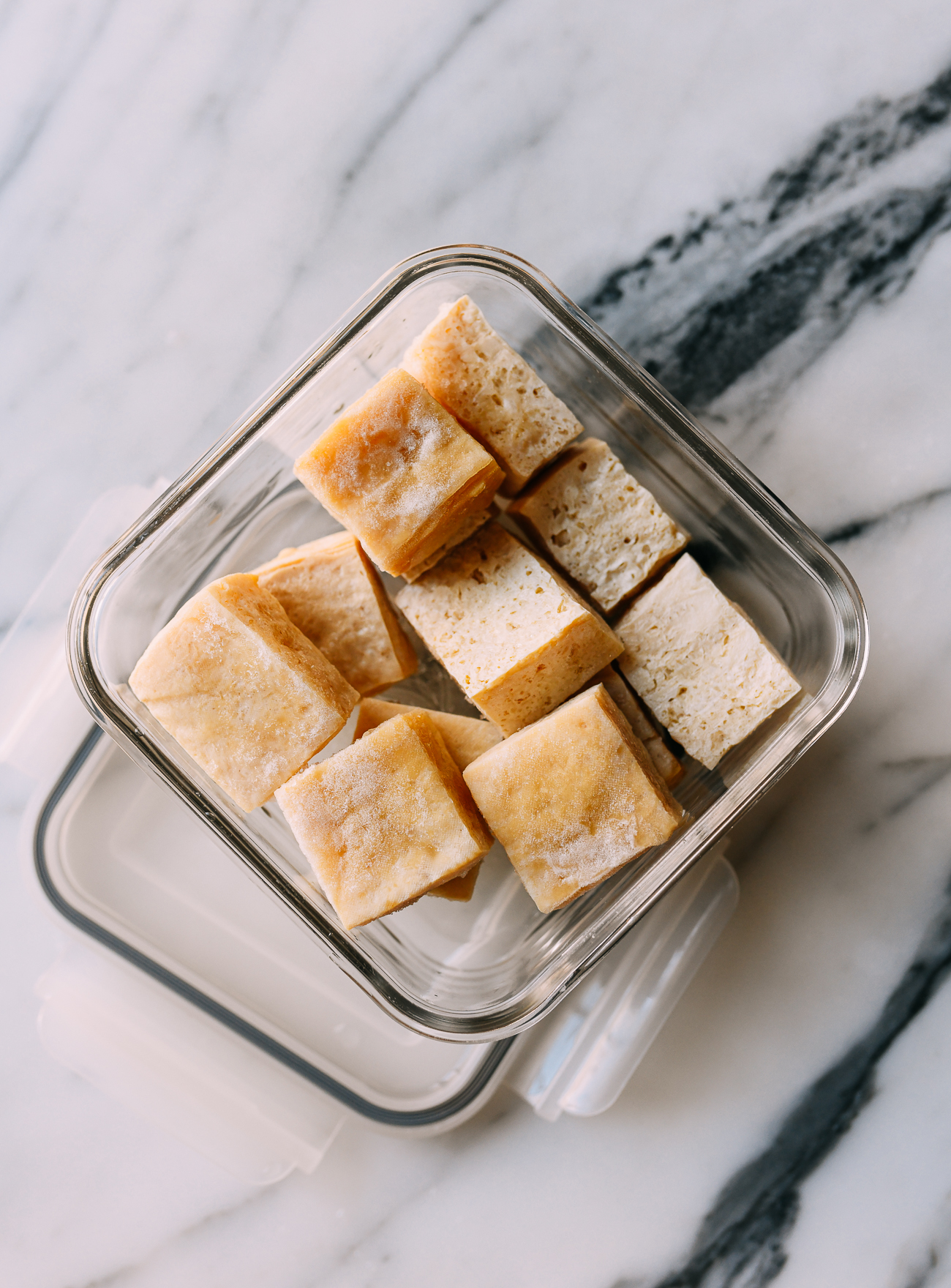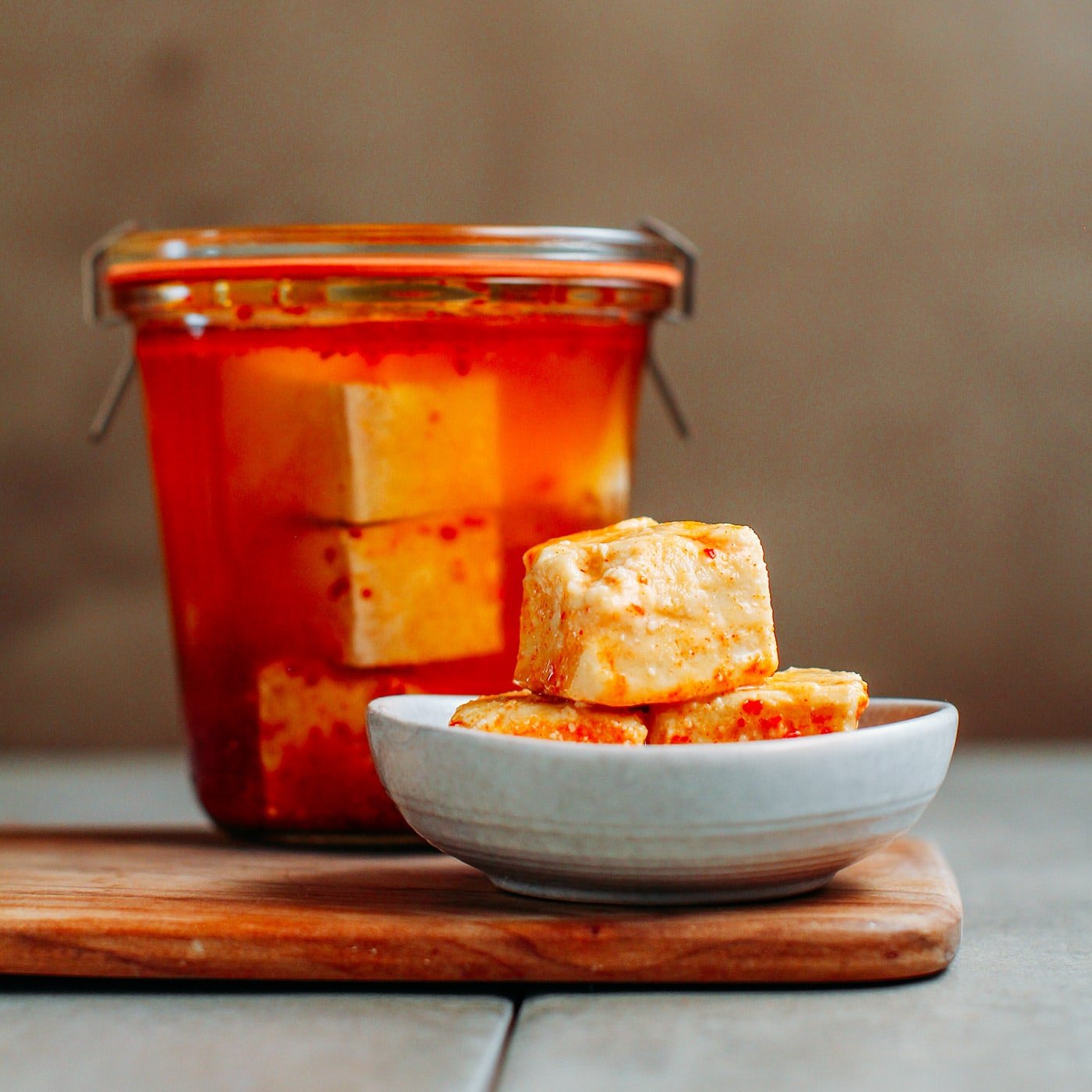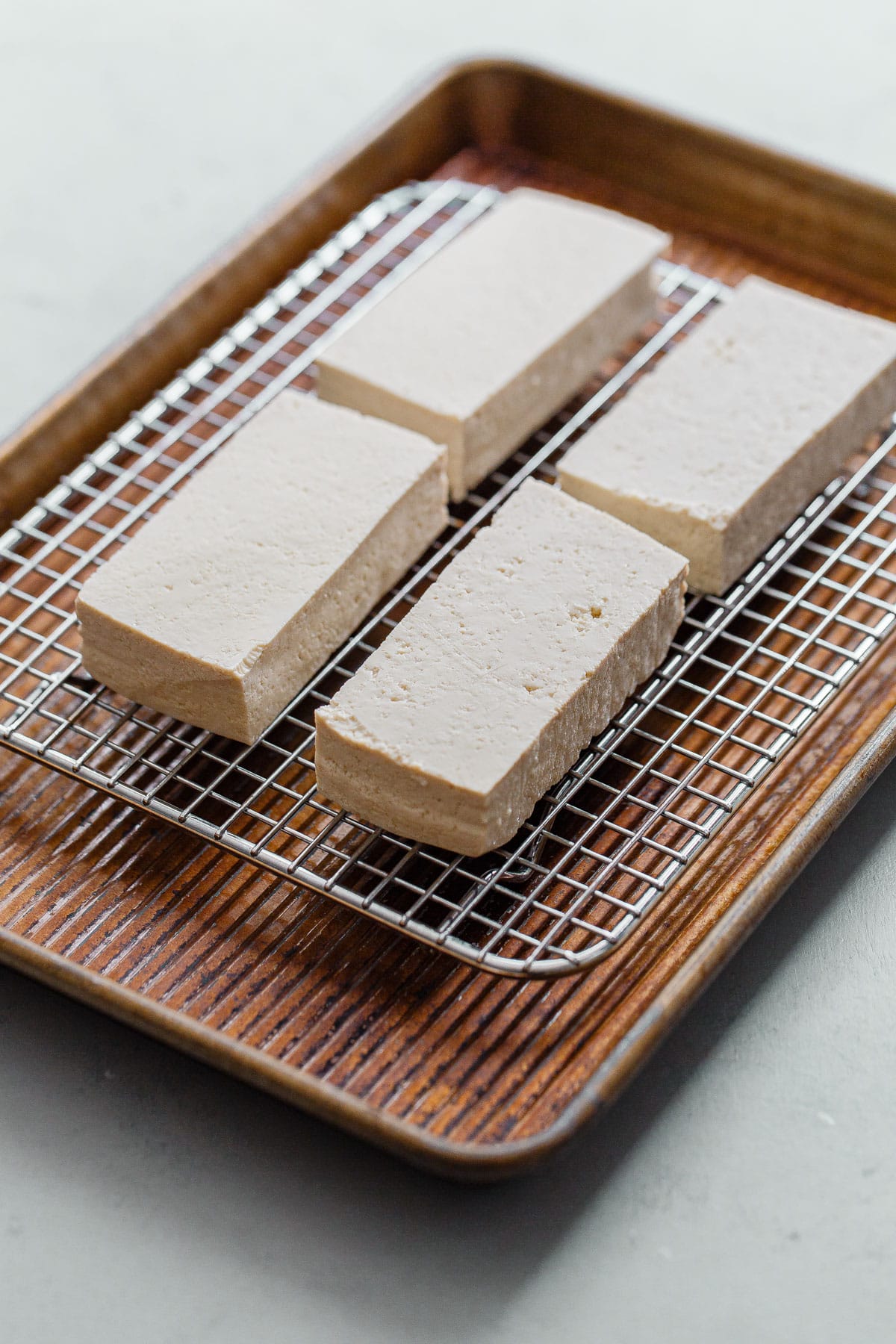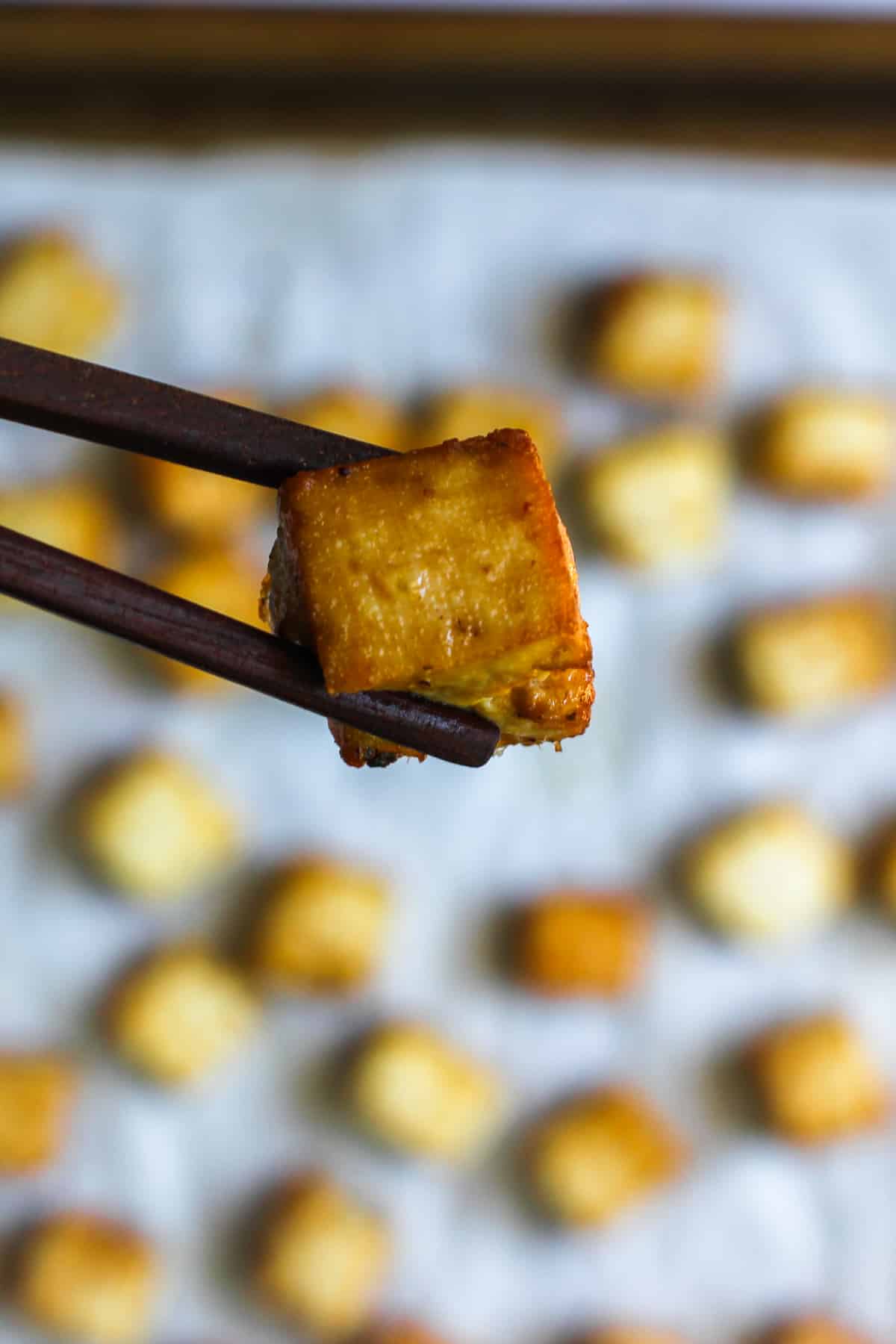Homemade Tofu (How to Make Tofu)
4.7
(14)
Your folders
Your folders
Prep Time: 30 minutes
Cook Time: 20 minutes

Ingredients
Export 2 ingredients for grocery delivery
Instructions
Step 1
Add dried soybeans to a fine mesh sieve and thoroughly rinse.
Step 2
Transfer soybeans to a large bowl and add enough cool water to cover by at least 2-3 inches. Cover and allow to soak at room temperature for 8+ hours, or overnight. The beans should be soft enough to split in half when gently squeezed.
Step 3
Drain the beans, give them a good rinse, and add them to a high-powered blender. Add in 3 cups of fresh water and blend until completely smooth.
Step 4
In the meantime, bring 4 additional cups of water to a gentle boil in a very large, heavy-bottomed stockpot or Dutch oven.
Step 5
Pour the blended soybeans into the water that's already begun boiling. Add another 1 cup fresh water into the blender and blend to pick up any soybean remnants. Then pour this into the pot. (You should now have used all 8 cups of water total.)
Step 6
Use a slotted spoon or sieve to skim the foam off the top of the mixture. Heat the raw soy milk over medium-high heat. Keep a very careful watch and stir regularly with a wooden spoon or rubber spatula. Stir and scrape along the bottom of the pot as soy milk has a tendency to form a film there which can scorch.
Step 7
**IMPORTANT** As it approaches boiling, soy milk will start to foam and expand very rapidly. To avoid it bubbling over, make sure you are using a pot with plenty of extra room, and be ready to turn off the heat and/or remove the pot from the burner IMMEDIATELY once it starts to expand. It's at this point that we're ready to move to the next step.
Step 8
Take a second stockpot and use either a colander or fine mesh sieve lined with cheesecloth, muslin, or a nut milk bag to strain the soy milk into it. Allow the mixture to cool for several minutes.
Step 9
When the mixture is cool enough for you to handle, wring out the soybean pulp to extract as much soy milk as possible. The pulp (also known as okara) can be saved and utilized in a variety of dishes.
Step 10
Bring the soy milk back up to a boil, then reduce the heat and simmer for about 10-15 minutes. (Longer removes more of the beany flavor.) The soy milk is now cooked.
Step 11
Turn the heat off and allow the soy milk to cool for about 5 minutes. (If you have a thermometer, we want it to cool to around 180°F.)
Step 12
During this time, prepare your nigari solution. Whisk 1 1/2 teaspoons powdered nigari into water until dissolved.
Step 13
Now is also the time to prepare your tofu mold. See the blog post for more details if needed. I like to line a wooden mold with reusable cheesecloth, which I have wet and thoroughly wrung out first.
Step 14
Pour 1/3 of the nigari solution into the soy milk and gently stir 3-4 times. The mixture should begin to curdle slightly.
Step 15
Pour another 1/3 of the nigari on top, gently stir again, and then cover the mixture and set a timer for 2 minutes to let it coagulate.
Step 16
Pour the remaining nigari solution on top of the soy milk and gently stir again. You should clearly see the tofu curds separating from the liquid. Avoid over-stirring and breaking up the curds. If it isn't curdling, reheat the mixture over low and after a few minutes you should see the separation occurring.
Step 17
Once the curds have formed, we will transfer them to our prepared mold for shaping. It's very helpful to remove some of the excess liquid first. I like to use a fine mesh sieve for this. Use it to press down the soy curds and isolate some of the liquid, which can then be ladled out and discarded. (You can see the images in the blog post or watch the video to see what I mean.)
Step 18
After you've removed a few cups of the extra liquid, you can now ladle or pour the soybean curds into your prepared tofu mold. Level out the top gently with a spatula or a spoon, then fold the overhanging cheesecloth neatly over the top and place the top on the mold.
Step 19
Next you will weigh the tofu down with a heavy object. I like to use a can of beans or tomatoes for about 30 minutes to yield a medium-firm block of tofu. You can add more weight and time for a firmer tofu, or less for a softer tofu.
Step 20
Once the tofu is done pressing, unwrap it from the cheesecloth and transfer it to a bowl of cold water. This will help it to firm up and will also remove any residual bitterness or sourness from the coagulant.
Top similar recipes
Curated for youYour folders

 565 views
565 viewsHow To Make Crispy Tofu
thekitchn.com
4.5
(6)
Your folders

 186 views
186 viewsHow to Make Frozen Tofu
thewoksoflife.com
4.8
(5)
20 minutes
Your folders

 290 views
290 viewsHow to Make Tofu Puffs
avegtastefromatoz.com
15 minutes
Your folders

 298 views
298 viewsHow to make tofu cheese
migrainereliefrecipes.com
Your folders

 709 views
709 viewsHow to Make Crispy Baked Tofu
cookieandkate.com
4.8
(320)
25 minutes
Your folders

 478 views
478 viewsHow to Make Crispy Fried Tofu
thehiddenveggies.com
5.0
(4)
5 minutes
Your folders

 327 views
327 viewsHow to Make Fermented Tofu (Chao)
fullofplants.com
5.0
(34)
Your folders

 407 views
407 viewsHow to Make Fermented Tofu (Chao)
fullofplants.com
5.0
(37)
Your folders

 217 views
217 viewsHow to Make Air Fryer Tofu
delishknowledge.com
5.0
(2)
10 minutes
Your folders

 276 views
276 viewsHow to Press Tofu
abeautifulplate.com
5.0
(9)
Your folders

 129 views
129 viewsHow to Cook Tofu
ministryofcurry.com
5.0
(9)
20 minutes
Your folders

 117 views
117 viewsHow to Store Tofu
thefoodietakesflight.com
Your folders
 14 views
14 viewsHow to Press Tofu
loveandlemons.com
5.0
(2)
Your folders

 278 views
278 viewsHow to Press Tofu
foodwithfeeling.com
15 minutes
Your folders

 426 views
426 viewsHow to Cook Tofu
loveandlemons.com
5.0
(44)
25 minutes
Your folders

 330 views
330 viewsHow to Grill Tofu
thekitchn.com
6 minutes
Your folders

 257 views
257 viewsHow To Make Tofu Taste Like Chicken
plantbasedandbroke.com
4.8
(5)
15 minutes
Your folders
 28 views
28 viewsHow to Make Crispy Air Fryer Tofu
jessicainthekitchen.com
Your folders

 250 views
250 viewsHow to make tofu taste like chicken
theeasyvegan.org
5.0
(9)
25 minutes